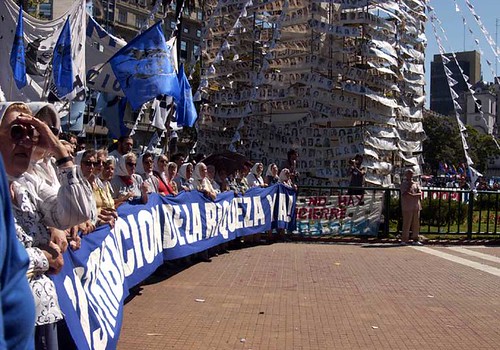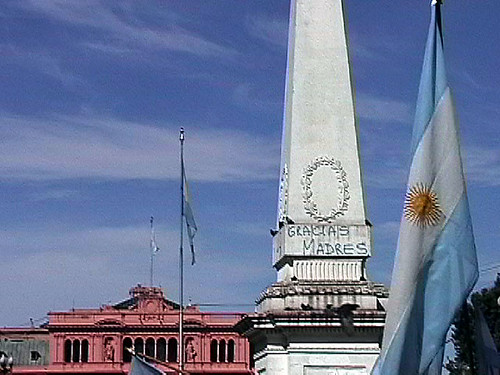
After 25 years and 1,500 Thursdays, the Madres de Plaza de Mayo made a historic last march in Plaza de Mayo. The Pirámide, around which the Madres march every week, was covered with photos of the disappeared.
In the year that is the 30th anniversary of the last military coup in Argentina, the final march by the Madres received surprisingly little news attention. While there were a good number of photographers in attendance, there were not the horde of videographers and photographers that seem to accompany every piquetero demonstration even though an announcement about the march had been on the Madres web site for at least two weeks.
There was an almost circus-like atmosphere to this Thursday’s event that, I thought, detracted from the solemnity of the regular weekly marches. Two stages of live music, food stalls, and a number of piquetero groups staked out spots on the Plaza. Yet, appropriately for this last march, the presence of the piqueteros ensured that this time there were more Argentines than foreign tourists in the Plaza with the Madres.
According to Clarín, however, there will still be Madres marching in the Plaza de Mayo on Thursdays. Foreigners often don’t learn that there are several groups of mothers associated with the Plaza de Mayo and the disappeared. The largest and most well-known is the Asociación Madres de Plaza de Mayo, headed by the outspoken, and sometimes controversial, Hebe de Bonafini. It was this group that ended its weekly marches. A splinter group is the Madres de Plaza de Mayo – Linea Fundadora, which separated from the original group in 1986; this group marches at the same time as the original group but does so separately and under its own banner.
Bonafini gave some odd statements explaining the end of the marches was because they do not have an enemy in the Casa Rosada and that “El presidente es amigo de Madres”. Technically, the Madres have called these marches “la Marcha de la Resistencia” and it is the march of the resistance by the Madres that is ending. Clarín reports that the Linea Fundadora will continue with its “Marcha de la Resistencia” on Thursdays. Also, it seems that the Madres led by Bonafini will continue marching on Thursday about the disappeared.
Then there also are the Abuelas de Plaza de Mayo, though they don’t march in the Plaza. The grandmothers focus on the children who were born in captivity when their pregnant mothers were kidnapped by the dictatorship as well as children that were kidnapped with their parents. A fascinating book on the work of the grandmothers in investigating the identity of these children who were placed with adopted families, sometimes with military men responsible for the disappearances, is Searching for Life: The Grandmothers of the Plaza De Mayo and the Disappeared Children of Argentina
The book is based on many interviews with the Madres and Abuelas. One account by a woman whose daughter, 8 months pregnant, and son were both disappeared highlights the suffering and courage of the mothers:
At first when my children disappeared I just laid down in bed, looking at the ceiling, blank. That was all I could do. My weight went down to forty kilos….I met a woman who said to me: “Why don’t you come on Thursday to the Plaza de Mayo? Take a little nail, that is how they will recognize you.” So I went, and I sat on a bench and my husband sat a little away from me. I had this little nail in my hand, and I saw that the others also had a little nail, and that is how I knew it was them….In the Plaza we secretly passed notes about where our meetings would be….We were simply housewives. Most of us had never done anything outside the home.
I first saw the Madres in Plaza de Mayo in early March of 2003 on my first visit to Buenos Aires. After they finished their half-hour demonstration in the Plaza, we followed the Madres as they made their way to a statue in front of the Casa Rosada. The Madres walked up onto the base of the statue to give a speech.
Standing near me was an American tourist, in his fifties, surrounded by his two college age children. He motioned to them and said, “You will remember this for the rest of your lives.”
Later I learned that the speech was a regular part of the Madres’ Thursday ritual. Normally, the speech is given by Hebe de Bonafini but she wasn’t there that day. Instead, it was given by one of the other prominent Madres. This was only a couple of weeks before the U.S. invaded Iraq but it was clear that war was coming. The Madres spoke out passionately against war, stressing that it is the mothers and the children who suffer the most during war.
In reading books about the last military government in Argentina, it’s chilling to come across statements in which the government labeled the disappeared as terrorists and justified its oppressive actions as means of combating terrorism. Groups like the Madres are needed to serve as a reminder, not only to Argentina but also to the world, of the atrocities that can be committed by governments in the name of patriotism.

Leaving the Plaza that day in March 2003, walking down Avenida de Mayo, I looked back and took a photograph that always will be my most emblematic memory of Buenos Aires. The Plaza’s centerpiece, the Pirámide de Mayo, is often covered with graffiti and contiually repainted white by the government. On that particular day it was adorned with the simple words, “Gracias Madres”.
January 27th, 2006 at 4:39 pm
Mödrarna slutar marschera – är det verkligen slut nu?
Jeff Barry hos bloggen Buenos Aires, City of Faded Elegance, berättar om den sista marschen för Madres de…
January 28th, 2006 at 10:47 am
Their reputation is tainted because of the abismal comments that crazy old woman Hebe de Bonafini says. She is totally nuts and should shut up.
January 28th, 2006 at 12:47 pm
“the atrocities that can be committed by governments in the name of patriotism.”
You failed to point out at the approval, encouragement and conceiling given to de “dictadores” by the American Administration, the School of the Americas and Henry Kissinger. They gave those brutal military men the sense of mission, faighting insidious communism in a world war scale.
In the end, they thought they’ll be rewarded with an American support to recover the Malvinas, a fatal misunderstanding of their role in world politics.
Anyway, your blog excels. I dropped here from “Global Voices” and I like your view of my beloved city very much. I praise also your effort at reading historians and traying to get sense from our rather paradoxical history.
January 29th, 2006 at 12:17 pm
Marc – I agree that many of Bonafini’s comments are extreme and have tained the Madres, which is very unfortunate.
Roberto – thanks for your comment. It’s sadly true that the US did support the right-wing dictatorships in Latin America in the US fight against communism. It seems that a lot of the anti-Americanism that exists in Latin America probably stems from the US support of these brutal governments in the past.
Argentina does have a complex, paradoxical and yet fascinating history.
January 31st, 2006 at 3:17 am
[…] More here. […]
May 30th, 2009 at 7:02 pm
Everyone talks about US intervention in Latin America but you all seem to forget the left-wing guerrillas that started it all. If those hadn’t tried to install communism in Latin America, there would have been no need for the US to intervene… I think that instead of always pointing fingers at the US, we should evaluate this within its historic context. The US support of right-wing dictatorships occurred during the Cold War. The US was clearly trying to prevent communism from expanding into the whole of Latin America. Nobody wants to live under a dictatorship, but hey, if the leftists had prevailed would it have been any different? I don’t think so… We would probably be living under a tyranny, like the Cubans who have endured so many years of communist oppresion, with human rights violations, lack of individual liberties etc etc etc
Don’t be fooled, left-wing dictatorships are no better, regardless of what some want to make us believe….
May 31st, 2009 at 1:50 pm
Hi Juan,
Good point that you make. I agree that authoritarian governments of either the left or right are not good ways of running a country. Of course, looking at the historical context then one also need to consider that those left-wing guerrillas were responding to right-wing oligarchical governments established long before US intervention.
What is certainly true is that neither extreme right-wing or extreme left-wing views are any way to run a country.
It’s unfortunate that many countries can’t find moderate politicians as leaders.
November 2nd, 2009 at 6:27 pm
Solo queria saber a que direccion escribir para saber si soy hija de desaparecidosss. Naci en el año 1976
November 2nd, 2009 at 7:13 pm
Abuelas de Plaza de Mayo
February 2nd, 2012 at 3:42 pm
[…] 14. Visit La Plaza de Mayo, where the Madres de Mayo used to march weekly. […]